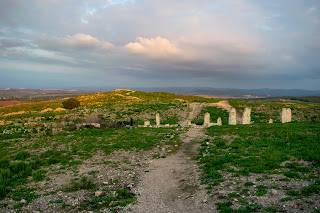I was unprepared for Tel Gezer.
The contrasts of Israel often take my breath away: the juxtaposition of the ancient and modern side-by-side, never more than a few feet (and millennia) apart... like watching children skip over the ruins of an ancient city while a modern one looks on half a mile away, or a family picnicking where a battle once took place.
What I knew about Tel Gezer before going was simple: as one of the places Solomon fortified, it is one of the remaining trio of cities with its iconic gates. I’ve been to the other 2, Megiddo and Hatzor; this was my chance to “collect all 3.”
What I didn’t know was that Tel Gezer overlooks the Valley on Ayalon, where God made the sun stand still for the battle in Joshua 10. The valley itself is huge; here are the views in each direction:
EPIC.
As sunset neared and turned the valley pink behind us, we walked back to the parking lot, passing these stone monuments.
These stones mark a place of ancient Canaanite worship. The soil below them has been tested, and the remains of burned infants had been found there, evidence of ancient child sacrifice to pagan gods.
I’d never been to a place like that, and, in the shock and the sorrow of the moment, I was struck again by another juxtaposition: how unimaginable it was to witness this place of sorrow at all, let alone maybe a mile from where the Creator of those infants made the very sun stay still in the sky.
It’s another contrast I’ll never forget.
What made it even more sobering was that the sign marking the monuments said nothing about the infant sacrifice that happened there. And nearby, a group of women sat in a circle. When one of my tour guides went to talk with them, they told her that this was a place of worship for femininity and fertility, and they were there to connect with each other and this place. They had no idea about the real truth of this place.









